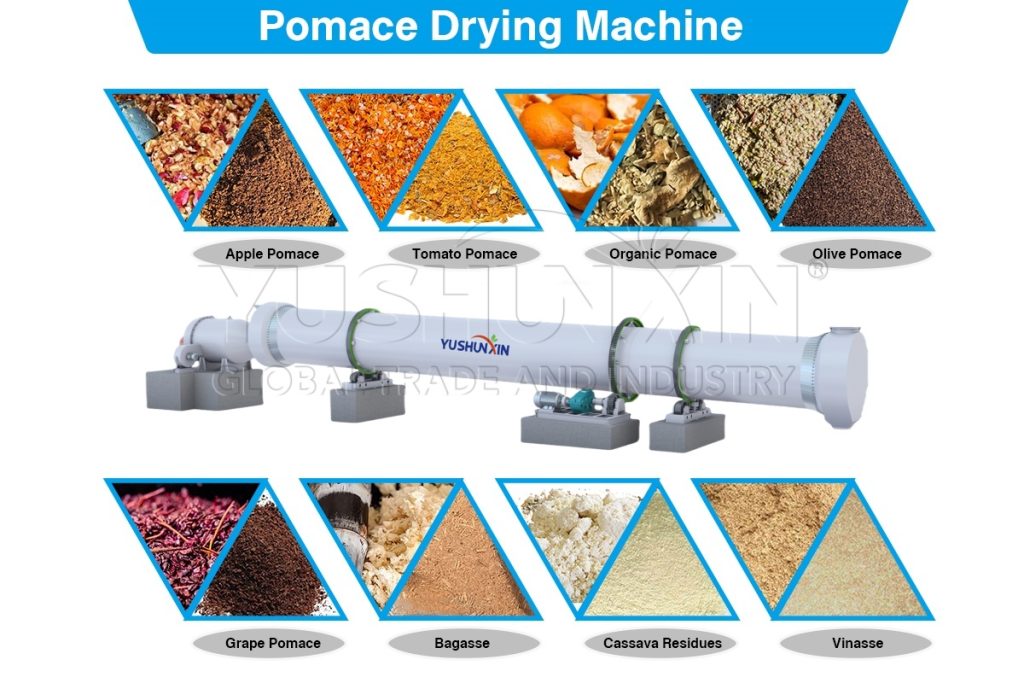The fertilizer market increasingly depends on efficient organic waste utilization and sustainable production methods. Among various technologies, pomace dehydration has become a vital process for transforming high-moisture organic residues into valuable raw materials for organic fertilizer production. Pomace—derived from fruit, vegetable, and winery processing—contains high moisture content that limits storage, transportation, and further composting or granulation steps. Effective water reduction not only improves material stability but also enhances fertilizer quality, leading to stronger sales growth. Understanding how this technology supports both waste management and fertilizer manufacturing helps enterprises adopt modern sustainable practices.

Part 1: What Types of Raw Materials Need Pomace Dehydration Before Fertilizer Production?
High-moisture organic waste from different industries provides potential feedstock for fertilizer making. For example, apple pomace, grape pomace, citrus peel residues, and vegetable pulp from juice or sauce processing all contain more than 85–90% moisture. Breweries generate spent grain, and oil mills produce soybean or sunflower cake, both of which need dewatering and drying before composting or granulation.
Each industry faces specific challenges. Juice factories require efficient moisture reduction to avoid microbial spoilage during storage. Wineries must stabilize grape pomace for safe transport to fertilizer plants. Food processors benefit from dehydration machines that prepare stable material for composting procedures and pelletizing processes. By using specialized dryers and dewatering equipment, these sectors can convert waste into uniform, low-moisture organic materials suitable for pomace fertilizer manufacturing systems.
Part 2: How Does Pomace Dehydration Technology Optimize the Fertilizer Production Process?
The pomace dehydration procedure serves as a foundation for modern fertilizer production. When the material’s moisture content drops from above 90% to below 10%, the subsequent composting and granulating steps become easier to control. In a typical production line, the process includes four stages: mechanical dewatering, thermal drying, composting, and wet granulation or pellet making. The dewatering machine removes free water first; the pomace dryer then performs deep drying to achieve stable moisture levels. Composting equipment completes biological stabilization, and finally, a granulator or pelletizer transforms the dried compost into granular organic fertilizer.
This complete manufacturing system design ensures efficient energy use and consistent fertilizer quality. Each drying stage directly affects particle formation and nutrient retention. Therefore, the pomace dryer becomes the core machine that determines the efficiency of the overall fertilizer production process.
Part 3: What Are the Key Features of Modern Pomace Dryers for Fertilizer Manufacturing Systems?
Modern pomace dryers adopt advanced dehydration technology that ensures uniform drying and maximum energy savings. The machines feature precise temperature control, adjustable drum rotation speed, and intelligent moisture monitoring. These designs enable continuous operation, high throughput, and stable water removal performance. Such drying equipment supports downstream systems including composting reactors, wet granulators, and pelletizers, which rely on properly dried pomace to maintain consistent granule size and nutrient distribution.
In fertilizer factories, robust pomace drying machinery reduces waste odor, prevents clumping, and lowers transportation costs. The technology also supports environmental compliance by controlling emissions and optimizing thermal energy recovery. Through integrated operation, the water reduction system strengthens the competitiveness of fertilizer producers in both domestic and international markets.
Conclusion
Pomace dehydration technology reshapes the fertilizer market by turning high-moisture organic residues into stable and valuable raw materials. By integrating dewatering machines, pomace dryers, composting units, and granulation equipment, fertilizer manufacturers achieve efficient production processes and consistent quality. The resulting organic fertilizer products meet market demands for sustainability and nutrient balance, leading to stronger sales growth and broader environmental benefits.
A professional drying equipment manufacturer—Yushunxin—provides advanced pomace dryer systems designed to support these goals. Through reliable technology and thoughtful engineering, the company helps fertilizer producers enhance production efficiency, ensure long-term material stability, and boost market competitiveness. You can visit: https://www.fertilizerdryer.com/pomace-drying-machine/